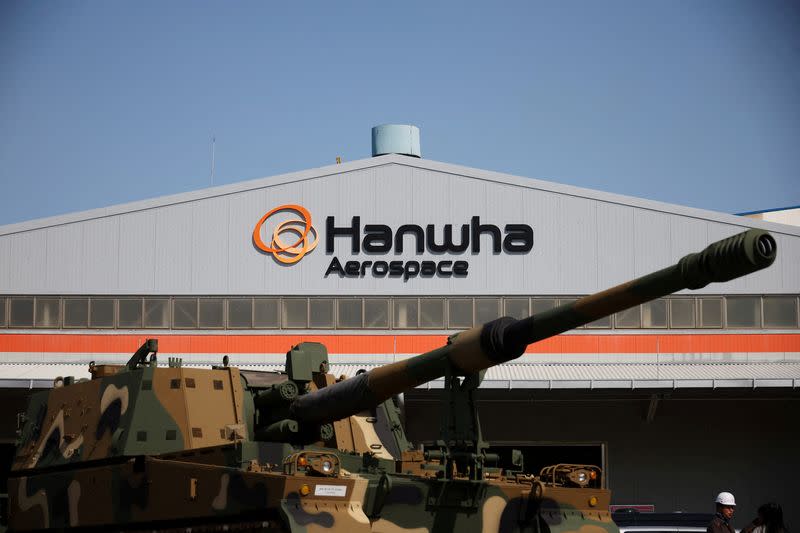Hanwha Aerospace's Europe land arms sales to double by 2027, CEO says

By Joyce Lee
SEOUL (Reuters) - Hanwha Aerospace, South Korea's biggest defence firm, expects European land arms revenue to double by 2027, driven by its willingness to ink deals to make its products in overseas customers' home countries.
"There's a phenomenon of blocs being formed, especially in Europe. They want to procure arms within the region," company CEO Son Jae-il said in an interview on Monday.
"In the past they just wanted to buy weapons, but now more than ever countries want to secure defence capabilities in their own countries."
South Korean officials and business executives have made joint production a key part of their pitch to prospective overseas customers to help ease their domestic political pressures to build weapons at home in order to create jobs and protect supply chains.
Hanwha, the world's largest exporter of howitzers, with more than 60% of the global export market, is at the forefront of South Korea's ramp-up of defence exports as Russia's invasion of Ukraine opened the door for contracts from Europe, the Middle East and Asia-Pacific.
South Korea has so far refused calls to directly arm Ukraine, but has provided non-lethal aid and made massive deals to arm the war-torn country's nervous neighbours.
Hanwha has signed a total of $9.2 billion deals with Poland to supply 364 howitzers and 290 missile defence systems since 2022, and won a $1 billion order from Romania to supply howitzers in July.
Hanwha's agreements with both countries include clauses to eventually produce arms within their borders, the company said.
The local production is made possible by robust support from the South Korean government, including the defense ministry that helps train the importing country's forces, the country's arms procurement agency, foreign ministry and even the Agency for Defense Development (ADD) which clears technology transfers, Son said.
Hanwha Aerospace's land arms order backlog jumped nearly tenfold in less than five years, from 3.1 trillion won at the end of 2020 to 30.3 trillion won ($22.49 billion) at the end of June, according to company data.
Hanwha's orderbook will continue to grow on rising exports to the Middle East after South Korean firms begin producing engines for K9 howitzers and Redback armoured vehicles by 2025, according to Korea Investment & Securities.
This year, Hanwha's overseas land arms sales exceeded domestic sales for the first time, Son said, adding that while they gave no region priority besides South Korea, the company is looking to become a trusted supplier to NATO countries.
The continuous demand for conventional weapons by South Korea's armed forces, which are locked in a standoff against North Korea across a heavily militarised border, has meant the country has maintained its supply chain and kept abreast of the technical developments of such weapons, Son said.
Facing off with North Korea has motivated South Korea to keep up with conventional weapon development while its ally the U.S. has had to focus on higher-end arms to compete with Russia and China, he said.
Although it differs from weapon to weapon and by situation, Son said Hanwha can usually supply arms at least one to two years faster than its competitors and at lower cost.
"In regions like the Indo-Pacific, we can fill the demand for a suite of arms that the United States doesn't do much, your howitzers, armoured vehicles, tanks."
Because of the relationship with the U.S., South Korean weapons are compatible with common NATO standards except for some elements like ammunition.
But even for ammunition, last year Hanwha Aerospace exported NATO-standard propellants for 155mm artillery shells, widely used by howitzers and field guns, for the first time to BAE Systems.
South Korea aims to become the world's fourth-largest arms exporter by 2027.
It ranked 10th between 2019-2023, according to the Stockholm International Peace Research Institute.
($1 = 1,347.1200 won)
(Reporting by Joyce Lee; Editing by Christian Schmollinger)